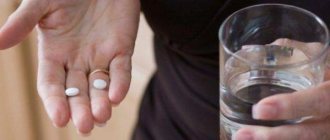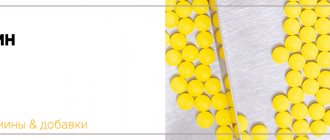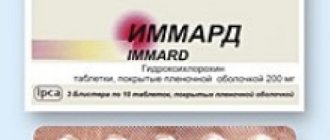Pharmacodynamics and pharmacokinetics
The active substance is diazepam , belongs to the class of benzodiazepines . The drug has anticonvulsant, sedative-hypnotic, central muscle relaxant effects. The principle of action is based on stimulation of benzodiazepine receptors. The anxiolytic effect is ensured by the effect of the drug on the amygdala complex, located in the limbic system. The medication reduces the severity of feelings of fear, concern, anxiety, and emotional stress. Thanks to the effect on the nonspecific nuclei of the thalamus and the reticular formation in the brain stem, a sedative effect , and the severity of symptoms of neurotic origin (fear, anxiety) is reduced.
Inhibition of the cells of the reticular formation in the brain stem provides a hypnotic effect . Increased presynaptic inhibition causes an anticonvulsant effect. The medication suppresses the spread of epileptogenic activity without affecting the excited state of the lesion. Inhibition of polysynaptic afferent, spinal inhibitory pathways causes a muscle relaxant effect of central origin.
The drug can cause a drop in blood pressure and expand the lumen of the coronary vessels. Sibazon increases the threshold of pain sensitivity. The medication is able to suppress parasympathetic, sympathoadrenal and vestibular paroxysms. The drug reduces the production of gastric juice at night.
The effectiveness of the drug is recorded on days 2-7 of therapy. In chronic alcoholism and withdrawal syndrome, diazepam reduces the severity of negativism , tremor , agitation, hallucinations , and alcoholic delirium. In patients with arrhythmias, cardialgia , paresthesia, the therapeutic effect is observed by the end of the first week.
Pharmacological group
Grandaxin is classified as an anxiolytic (anti-anxiety) drug or tranquilizer. Most representatives of this group, in addition to anti-anxiety effects, also exhibit others, including:
- sedative – decreased mental and motor activity;
- hypnotic;
- anticonvulsant;
- muscle relaxant - relaxing.
Such effects make it impossible to take such drugs during the day while driving.
Grandaxin is a fundamentally new tranquilizer with a pronounced anxiolytic effect. Its active ingredient is tofisopam, an atypical benzodiazepine derivative. It is synthesized by transforming the molecular structure of diazepam. Thanks to this feature, it is not capable of causing addiction and withdrawal symptoms.
The action of benzodiazepines is based on increasing the sensitivity of receptors to GABA - gamma-aminobutyric acid. This is the main neurotransmitter that causes inhibition in the brain and thereby stops excitement and has a calming effect. However, its excess provokes the opposite reaction - hyperactivity, anxiety, trembling in the arms and legs.
All benzodiazepines are divided into 3 classes, taking into account the predominant effect:
- with anxiolytic;
- with sleeping pills;
- with anticonvulsant effect.
Most representatives have all of the listed properties with one pronounced one. Grandaxin has an anti-anxiety effect, and other manifestations are practically absent.
Considering that the drug does not cause a feeling of drowsiness, relaxation and lethargy, and does not interfere with concentration, it is called a daytime tranquilizer and it is allowed to combine its use with driving, but only after consulting a doctor.
Indications for use
Instructions for use of Sibazon are recommended to prescribe the drug for all forms of anxiety disorders.
The drug is effective for insomnia , dysphoria (combination therapy), spastic conditions (against the background of damage to the brain, spinal cord: athetosis, cerebral palsy , tetanus), spasm of skeletal muscles, rheumatic pelvispondyloarthritis, arthritis, bursitis, myositis, progressive chronic polyarthritis , vertebral syndrome, tension headache, angina pectoris.
The medication is prescribed for alcohol withdrawal syndrome: agitation, tension, anxiety, transient reactive states, tremor. For psychosomatic disorders in gynecological practice, for gestosis, status epilepticus, peptic ulcer of the digestive system, arterial hypertension, eczema, the drug is prescribed as part of complex therapy.
The drug is used for drug poisoning, Meniere's disease , as a premedication before endoscopic intervention, surgical treatment under general anesthesia.
The drug is used to relieve epileptic seizures, paranoid-hallucinatory states , motor agitation in psychiatric and neurological practice, with premature placental abruption, to facilitate labor.
Notes
- Mashkovsky M.D.
Medicines. — 16th ed. - M.: New Wave, 2012. - P. 78. - 1216 p. — ISBN 978-5-7864-0218-7. - Chapter 5. Medicine and age. 4.1. Pregnancy and medications // Zmushko E.I., Belozerov E.S.
Medication complications. - St. Petersburg: Peter, 2001. - 448 p. — (Quick reference). — 3000 copies. — ISBN 5-272-00168-0. - ↑ 123
Interaction of drugs and the effectiveness of pharmacotherapy / L. V. Derimedved, I. M. Pertsev, E. V. Shuvanova, I. A. Zupanets, V. N. Khomenko; edited by prof. I. M. Pertseva. - Kharkov: Megapolis Publishing House, 2001. - 784 p. — 5000 copies. — ISBN 996-96421-0-X. - Diazepam (Valium) [LifeBio.wiki] (undefined)
. lifebio.wiki. Date accessed: December 20, 2022.
Contraindications
Sibazon is not prescribed for diazepam intolerance, acute intoxication with other medications, acute alcohol intoxication with damage to vital organs, closed-angle glaucoma, myasthenia gravis, pregnancy, severe COPD, absence seizure, acute respiratory failure, breastfeeding.
For elderly people, with a history of epileptic seizures and epilepsy, with spinal and cerebral ataxia, with liver or kidney failure, with organic diseases of the brain, with sleep apnea , a tendency to abuse psychoactive medications, with a history of drug dependence, Sibazon is prescribed with caution .
Side effects
The use of Sibazon, especially at the initial stage of treatment, can cause various adverse reactions.
Nervous system: ataxia , decreased ability to concentrate, poor coordination of movements, disorientation , dullness of emotions, fatigue, dizziness, drowsiness, slow speed of motor and mental reactions, gait instability, anterograde amnesia , euphoria , catalepsy, depressed mood, tremor of the limbs, depressive mood, weakness, confusion, euphoria, myasthenia gravis during the day, headache, paradoxical reactions, dysarthria , hyporeflexia , irritability, acute agitation, hallucinations, muscle spasms, suicidal tendencies, fear, psychomotor agitation, outbursts of aggression, insomnia, anxiety, uncontrolled body movements.
Digestive tract: decreased appetite, vomiting, nausea, dry mouth, constipation, jaundice, increased levels of liver enzymes, hypersalivation .
Hematopoietic organs: neutropenia, leukopenia, anemia, agranulocytosis , thrombocytopenia.
Cardiovascular system: with parenteral administration, a drop in blood pressure, tachycardia, and palpitations are noted.
Genitourinary system: dysmenorrhea , impaired libido, disturbances in the renal system, urinary retention.
It is possible to develop allergic reactions in the form of itching and rashes.
Description of the effect of the drug Sibazon on the fetus when treating the mother during pregnancy: suppression of the sucking reflex in newborns, disturbances in the respiratory system.
Venous thrombosis or phlebitis, swelling and redness at the injection site may develop at the injection site.
Other reactions: visual disturbances in the form of diplopia , weight loss, dysfunction of external respiration, depression of the respiratory center, bulimia, weight loss.
When the medication is abruptly discontinued or the dose is reduced, a “withdrawal” syndrome develops, which is manifested by anxiety, irritability, depression, increased sweating, depersonalization , dysphoria, sleep disturbance, nervousness, spasm of smooth muscle tissue, acute psychosis, hallucinations, convulsions, sleep disturbance, headache, hyperacusis, photophobia, paresthesia, perceptual disorder, tremor.
hypothermia , and muscle hypotension are observed in premature and full-term infants
Instructions for use of Sibazon (Method and dosage)
The drug is prescribed orally, as well as intravenously, intramuscular injections of Sibazon, the instructions for use also include complex therapy with solution and tablets.
The dosage of the drug is carried out depending on the sensitivity to the drug, the clinical picture, and individual reaction.
In psychiatric practice: for phobias, states of dysphoria, hypochondriacal and hysterical reactions, neuroses, the medication is prescribed 2-3 times a day, 5-10 mg.
As an anxiolytic, diazepam is taken 2-4 times a day, 2.5-10 mg. In some cases, the amount of the drug can be increased to 60 mg per day.
In case of alcohol withdrawal syndrome, the drug is prescribed on the first day 3-4 times at a dose of 10 mg, then the amount of medication is halved.
For patients with atherosclerosis, the elderly and those with weakened immune systems, diazepam is prescribed twice a day, 2 mg.
In neurological practice, for degenerative diseases and spastic conditions of central origin, Sibazon is taken 2-3 times a day, 5-10 mg.
In rheumatology and cardiology: for arterial hypertension - 2-3 times a day, 2-5 mg, for angina - 2-3 times a day, 2-5 mg, for vertebral syndrome - 4 times a day, 10 mg.
The drug is used as part of complex therapy in the treatment of myocardial infarction: initial dosage – 10 mg intramuscularly, then 5-10 mg orally 1-3 times a day.
During defibrillation, the drug is administered as a premedication in separate doses intravenously, slowly, 10-30 mg.
For spastic conditions of rheumatic origin and for vertebral syndrome: the initial amount of the drug is 10 mg intramuscularly, then 5 mg orally 1-4 times a day.
In gynecological practice and obstetrics: for menstrual and menopausal disorders, for psychosomatic pathology, gestosis, it is recommended to take 2-5 mg of diazepam 2-3 times a day.
The initial dose for preeclampsia is 10-20 mg intravenously, followed by oral administration three times a day, 5-10 mg.
Continuous treatment is carried out for premature placental abruption until the fetus fully matures.
Premedication in surgical practice and anesthesiology: before surgery, give 10-20 mg of diazepam.
Pediatrics: for spastic conditions of central origin, for reactive and psychosomatic disorders, the amount of the drug is increased gradually.
For severe repeated epileptic seizures and status epilepticus, Sibazon is taken parenterally: for children under five years of age, slowly intravenously 0.2-0.5 mg every 2-5 minutes, maximum 5 mg.
For spinal cord injuries accompanied by hemiplegia or paraplegia, for chorea, the drug is administered intramuscularly at 10-20 mg.
For motor excitation, the drug is prescribed intravenously or intramuscularly three times a day, 10-20 mg.
To relieve muscle spasms (severe form), the drug is administered intravenously in a single dose of 10 mg.
How to take it correctly
Grandaxin is a small, round, disc-shaped tablet with the GRANDAX logo. They are white or gray in color and have virtually no odor. Located on a blister of 10 pieces.
The dosage of 1 tablet is 50 mg. The package contains 20 or 60 tablets.
Once in the digestive tract, Grandaxin is quickly absorbed into it. Undergoing transformation in the liver, it enters the blood. Here it reaches its maximum concentration 2 hours after administration. It is excreted by the kidneys and does not accumulate in the body.
The dose of the drug depends on the severity of the condition. It is calculated and prescribed only by a doctor. Self-medication is unacceptable. Usually the scheme is as follows: 1–2 tablets. from 1 to 3 times a day.
The maximum dose per day is 300 mg, in children – 200 mg.
Due to the fact that the drug accumulates in the liver and is evacuated through the kidneys, the drug is prescribed to patients with renal and liver failure with caution. In such patients, the severity and duration of the effect may change, as well as the development of side effects. In this regard, their dose is reduced by half. The same scheme is used for elderly people.
In case of an overdose of the drug, complications such as vomiting, changes in consciousness, coma, seizures and impaired respiratory function are possible.
Grandaxin is not used in parallel with cyclosporine and immunosuppressants such as tacrolimus, sirolimus.
Tablets can intensify the effect of drugs that depress the activity of the central nervous system: analgesics, sedatives and hypnotics, etc.
The use of Grandaxin along with alcohol, smoking, barbiturates, along with antiepileptic therapy reduces its activity.
It is strongly recommended to take Grandaxin before 17.00 to avoid insomnia.
The drug is available with a doctor's prescription. The average cost of 20 tablets is 400 rubles, 60 tablets - 900 rubles.
Overdose
Taking increased doses of the drug causes decreased reflexes, paradoxical arousal , confusion, drowsiness, deep sleep, decreased response to painful stimuli, stupor, areflexia, bradycardia , tremor, impaired visual perception, depression of the respiratory and cardiovascular systems, nystagmus, collapse , to whom.
It is recommended to prescribe enterosorbents, gastric lavage, perform artificial ventilation of the lungs if necessary, and maintain blood pressure and respiratory parameters.
A specific antagonist is flumazenil , which is used exclusively in hospital settings. Flumazenil, a benzodiazepine antagonist, is not recommended for use in patients with epilepsy who are taking benzodiazepines due to the risk of provoking epileptic seizures.
Hemodialysis has not proven effective.
Story
The drug was invented by Leo Sternbach from the Hoffmann-La Roche company. It appeared on the market in 1963 and immediately gained great popularity. From 1969 to 1982, diazepam had the largest sales of any pharmaceutical product in the United States. In 1978, a record amount of it was sold - 2.3 billion tablets. Drugs of the benzodiazipam group are widely used for non-medical purposes: according to studies in 2011, there were 28.7% of them. According to this indicator, they are second only to opiates. For example, in Sweden, diazepam was found in the blood of drivers in 26% of cases of drunk driving, and in Northern Ireland this figure reached 87%.[4]
Interaction
Sibazon enhances the severity of the inhibitory effect on the central nervous system of antidepressants , neuroleptics, sedatives, antipsychotic medications , muscle relaxants, drugs for general anesthesia, and narcotic analgesics.
Enhanced action and prolongation of the half-life are recorded when taken simultaneously with valproic acid , propoxyphene, propranolol , metoprolol, ketoconazole, isoniazid, fluoxetine, disulfiram, erythromycin, oral contraceptives, cimetidine and other microsomal oxidation inhibitors.
The effectiveness of the drug is reduced when taking inducers of microsomal liver enzymes. An increase in psychological dependence and increased euphoria is recorded when taking narcotic analgesics .
Antacid medications do not affect the complete absorption of diazepam, but reduce the rate of absorption. When taking antihypertensive drugs, there is an increase in the severity of the decrease in blood pressure. The simultaneous use of clozapine increases the depression of respiratory function. As a result of competition for binding to proteins, the risk of digitalis intoxication increases when using low-polarity cardiac glycosides.
In patients with parkinsonism while taking diazepam, the effectiveness of levodopa is reduced. The elimination time of the drug is prolonged when treated with omeprazole. The activity of the drug decreases with the use of psychostimulants, analeptics, and MAO inhibitors.
Sibazon can enhance the toxicity of zidovudine. Theophylline reverses and reduces the sedative effect of the drug. Rifampin reduces the concentration of the active substance, increasing its elimination.
Sibazon is incompatible with other medications, which prohibits mixing the drug with other medications in the same syringe.
special instructions
Intravenous infusion of diazepam is carried out slowly, preferably into a large vein at a rate of 5 mg (1 ml) per minute. Intravenous continuous infusions are unacceptable due to the risk of sediment formation and drug adsorption.
During therapy with sibazon, complete abstinence from drinking alcoholic beverages is required. In case of severe pathology of the renal and hepatic systems, regular monitoring of liver enzymes and peripheral blood patterns is required.
Long-term therapy with high doses of medication leads to drug dependence. Long-term treatment is carried out in exceptional cases. Abrupt cessation of taking the drug leads to withdrawal syndrome , which is manifested by confusion, anxiety, myalgia, headaches, tension, hyperacusis , depersonalization, derealization, tactile hypersensitivity, photophobia, epileptic seizures, hallucinations.
If during treatment the patient experiences such unusual reactions as anxiety, increased aggression, thoughts of suicide , insomnia, shallow sleep, increased muscle cramps, hallucinations, acute states of agitation, then the drug is discontinued.
In the first days of therapy, as well as with abrupt discontinuation of the drug in patients with epileptic seizures and a history of epilepsy, an acceleration in the development of seizures and status epilepticus is observed.
During pregnancy, diazepam can be prescribed only for “vital” indications, in exceptional cases. The use of Sibazon in the first trimester of pregnancy increases the likelihood of developing birth defects , and also has a pronounced toxic effect on the fetus. The use of the drug in late pregnancy leads to inhibition of the central nervous system in newborns. With constant use during pregnancy, the formation of physical dependence is observed, and sometimes “withdrawal” syndrome is recorded in newborns.
Young children are most sensitive to the depressant effects of benzodiazepines on the central nervous system. It is not recommended to prescribe drugs containing benzyl alcohol to newborns due to the risk of developing a fatal toxic syndrome, manifested by difficulty breathing, depression of the central nervous system, metabolic acidosis , drop in blood pressure, intracranial hemorrhage , epileptic seizures, and renal failure.
When diazepam is used within 15 hours before delivery in doses exceeding 30 mg, apnea, respiratory depression in newborns, hypothermia, weak sucking, drop in blood pressure, decreased muscle tone, “floppy baby” syndrome, and impaired metabolic processes in response may develop. to cold reaction .
Sibazon affects driving and performing complex work.
Not described on Wikipedia.
MNN: Diazepam.
Grandaxin and other tranquilizers
Due to its mild and selective effect, the drug has a minimum of side effects, unlike other anxiolytics. It does not cause the negative consequences inherent in most representatives of this group. The main ones are:
- "Behavioral Toxicity." Manifested by increased sleepiness during the day, weakness and malaise. Characterized by decreased reaction speed and inability to concentrate. Coordination of movements is impaired, and confusion may occur.
- Addiction. A common problem when taking tranquilizers. There is a possibility that it will worsen even to substance abuse. But more often, addiction develops with long-term treatment with such drugs, with an unauthorized increase in dose or concurrent use of alcohol.
- Withdrawal syndrome occurs when you suddenly stop using a tranquilizer. In this case, the symptoms of the disease return to the patient in a more pronounced or even complicated form.
Grandaxin does not exhibit such complications. It is low-toxic and resistance to it is not developed upon repeated use. Therefore, it is taken during the daytime.
The drug does not reduce physical and mental activity and does not lead to drowsiness. It does not suppress the efficiency of perception, the speed of reactions, and does not interfere with professional activities.
Sibazon's analogs
Level 4 ATC code matches:
Bromazepam
Helex
Rudotel
Relium
Nozepam
Tazepam
Xanax
Elenium
Valium Roche
Alprazolam
Tofisopam
Diazepam
Grandaxin
Mezapam
Seduxen
Relanium
Lorazepam
Analogues are: Diazepam , Relanium , Relium .



